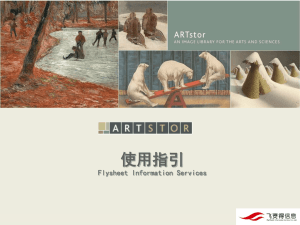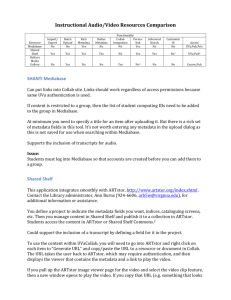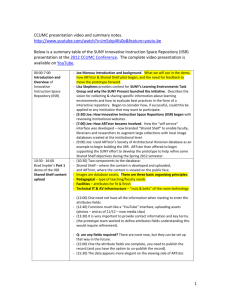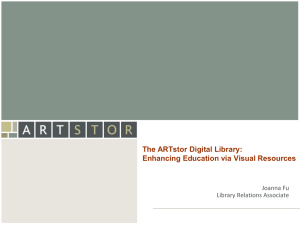ARTstor Core Data Dictionary
advertisement
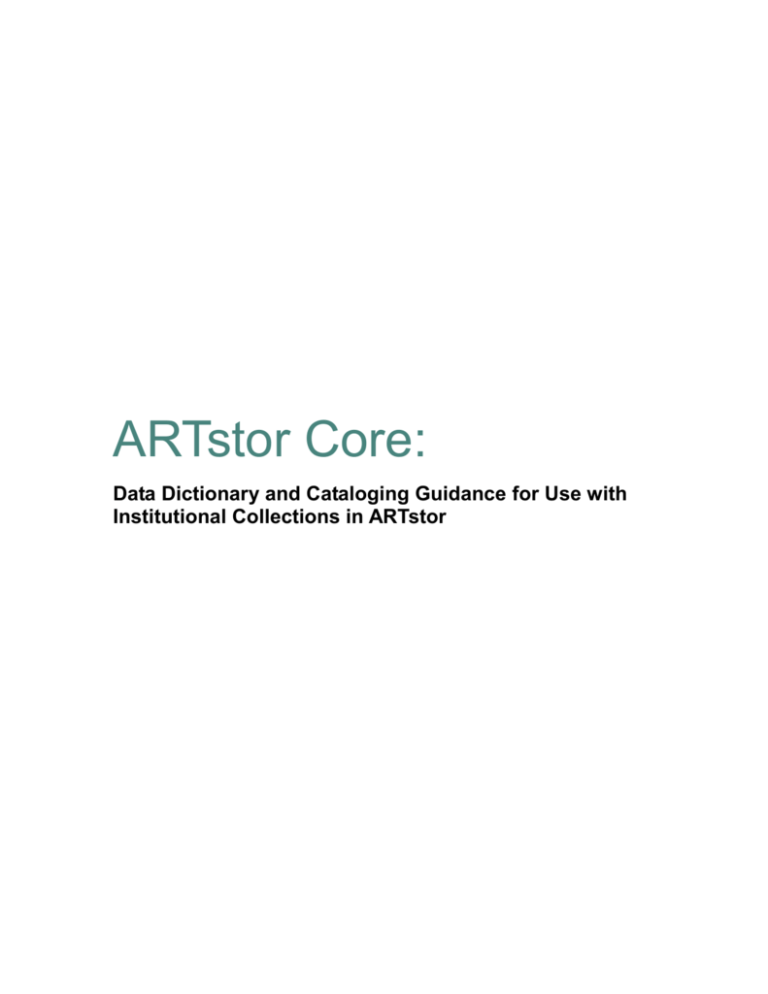
ARTstor Core: Data Dictionary and Cataloging Guidance for Use with Institutional Collections in ARTstor ARTstor Core Data Dictionary and Cataloging Guidelines Table of Contents Introduction 1 ARTstor GENERAL RULES 2 DATA DICTIONARY 4 Creator Culture ARTstor Country Title Work Type ARTstor Classification Style/Period Date Image Date ARTstor Earliest Date ARTstor Latest Date Location Creation/Discovery Site Materials/Techniques Measurements Image View Description Description State/Edition Inscriptions Condition Conservation/Treatment Photographer Repository Repos. Accession Number Provenance Bibliography Subject Collection Record ID Image ID Record Source Image Source Rights 4 4 5 5 6 6 6 7 7 8 8 9 9 10 10 11 11 12 12 13 13 13 14 14 15 15 16 16 17 17 17 18 18 APPENDIX A: ARTstor CLASSIFICATION Controlled Values 19 APPENDIX B: ARTstor GEOGRAPHY Controlled Values 20 APPENDIX C: Reference Works (authorities, schemata, thesauri) 24 ARTstor Core Data Dictionary and Cataloging Guidelines | DRAFT | 2/12/2016 | Page i ARTstor Core Data Dictionary and Cataloging Guidelines Introduction Many institutions that are just beginning to set up a digital image database have asked if ARTstor could share its schema or suggest one that would be compatible with ARTstor’s to facilitate the ingest process for institutional collections hosted in ARTstor. We have been hesitant to encourage the adoption of ARTstor’s current schema because it is undergoing some significant changes and because it is not particularly “user friendly.” Having developed, in 2003, an XML schema based in large part on the VRA Core 3.0, ARTstor is now developing a schema that is much broader in scope to better capture the heterogeneous data sets we’ve received thus far from various content contributors for the general ARTstor Digital Library. However, the full set of ARTstor metadata fields is more granular than most need for their institutional collections. So rather than expect others to accommodate their database to ARTstor’s specific needs, we developed what we hope is a useful subset of fields and a data dictionary that is easy to use yet still flexible enough to accommodate a variety of situations where cataloging of works of art is central to the project. The schema is essentially flat. In creating it, we kept in mind both the new ARTstor schema and the VRA Core 4.0 schema. We have heard from a number of people requests for a basic element set that will efficiently capture at least minimal data about a lot of images and that will require a minimum of database “design.” Thus, we have avoided sub-elements, attributes, the work/image distinction, and elements designed to capture indexing and authorized terms. Apart from a few elements that may be used to make data sets compatible with ARTstor’s advanced search capabilities, the schema and cataloging guidelines assume simple, display-based data values. Like the pared down schema and dictionary, the cataloging guidelines are simplified for a couple of reasons. For one, we don’t want to be too prescriptive and we hope that the schema will be adaptable to varying local needs. For another, we encourage the use of the VRA’s Cataloging Cultural Objects (CCO). While the Categories for the Description of Works of Art (CDWA) and CDWA Lite helped guide the creation of the list of elements and provided many of the definitions, we expect that CCO will be extremely helpful in formatting data values. The “ARTstor Core” is designed to satisfy a particular need and to help make it possible for ARTstor to easily ingest contributed content. While we hope it serves those purposes, it is not a standard in its own right, and will, in no way, replace such invaluable resources as VRA Core 4.0, CDWA, and CCO. Also, if you feel this element set is too restrictive to display your data appropriately within ARTstor, please contact us to discuss development of a custom map from your fields to ARTstor’s full set of metadata elements. ARTstor Core Data Dictionary and Cataloging Guidelines | DRAFT | 2/12/2016 | Page i ARTstor General Rules Creator Culture ARTstor Country Title Work Type ARTstor Classification Style/Period Date Image Date ARTstor Earliest Date ARTstor Latest Date Location Creation/Discovery Site Materials /Techniques Measurements Image View Description Description State/Edition Inscriptions Condition Conservation/Treatment Photographer Repository Repos. Accession Number Provenance Bibliography Subject Collection Record ID Image ID Record Source Image Source Rights Required Controlled * ARTstor Geography Authority * ARTstor Classification Authority * * Numeric value only Numeric value only Multiple Values ARTstor Core Data Dictionary and Cataloging Guidelines | DRAFT | 2/12/2016 | Page -2- Required: Fields that must be populated with data. Conditionally Required: * these fields are only required if you would like to take advantage of advanced search features in ARTstor Controlled: Fields with specific rules governing data entry as described in the cataloging guidelines. Multiple Values: Fields that may contain multiple values. Values may be entered in one single field or they may be entered in separate columns. When entered in a single field, we suggest using a delineator to mark the beginning of one value and the next. When entering values in multiple columns, create a new column with the same column name for each new value. ARTstor Core Data Dictionary and Cataloging Guidelines | DRAFT | 2/12/2016 | Page -3- Data Dictionary and Cataloging Guidance Creator Description: Name, brief biographical information, and roles (if necessary) of the named creator or creators in the design and production of the work, presented in a syntax suitable for display to the end-user and including any necessary indications of uncertainty, ambiguity, and nuance. Guidelines: Use ULAN (http://www.getty.edu/research/conducting_research/vocabularies/ulan/) or, if not in ULAN, another authorized display form. The name should be in natural order, if possible. Nationality and life dates may be included. Examples: a. Michel Erhart (German, ca. 1440-after 1522) b. probably designed by Giambologna (Flemish, 1529-1608, active in Italy); casting attributed to Pietro Tacca (Italian, 1577-1640) c. Albrecht Dürer Culture Description: Name of the culture, people, or nationality from which the work originated. Guidelines: Particularly useful when Creator is unknown. Use AAT, if possible. In this field, the adjectival form is used. Examples: Celtic Egyptian Native American Sioux ARTstor Core Data Dictionary and Cataloging Guidelines | DRAFT | 2/12/2016 | Page -4- ARTstor Country Description: A type of “nationality” field, though not in adjectival form; country refers to the modern name of the country (use ULAN’s nationality as a guide). ARTstor Country data will not display with the record in ARTstor. It is a functional field that, if populated, allows ARTstor users to filter search results by selecting values from the Geography list when performing advanced searches. Guidelines: This is a controlled field. Select a term or terms from the list of countries currently used by ARTstor in Appendix B, ARTstor Country Authority. These terms are identified, in TGN, as nations. Examples: Côte d'Ivoire Kazakhstan United Kingdom Title (required field) Description: Titles, identifying phrases, or names given to a work of art, architecture, or material culture. Guidelines: Use typical, American style, title case. Leading articles may be dropped. String phrases together for descriptive titles, using punctuation to separate phrases. For details, add “detail” at the end following a semi-colon after the main title. If necessary, describe the detail. If there are two titles, or a formal and informal title, or the title comes in two languages, you may put the preferable one first and put parentheses around the 2nd one. Examples: Chartres Cathedral; west facade; central doorway Landscape with Storm; detail of ducks in foreground Déjeuner sur l’Herbe (Luncheon on the Grass) Two Masks in Performance ARTstor Core Data Dictionary and Cataloging Guidelines | DRAFT | 2/12/2016 | Page -5- Work Type Description: Term or terms identifying the specific kind of object or work being described. Guidelines: Use this field for greater specificity than ARTstor Classification, though the degree of specificity may depend on local practices. Examples: furniture chair fresco ARTstor Classification Description: Term used to categorize a work by grouping it together with other works on the basis of similar characteristics, including materials, form, shape, function, etc. ARTstor Classification data will not display with the record in ARTstor. It is a functional field that, if populated, allows ARTstor users to filter search results by selecting values from the Classification list when performing advanced searches. Guidelines: This is a controlled field. Select a term or terms from the list of 16 terms provided in Appendix A, ARTstor Classification Authority. Examples: Architecture and City Planning Decorative Arts, Utilitarian Objects and Interior Design Drawings and Watercolors Style/Period Description: Term that identifies the named, defined style, historical or artistic period, movement, group, or school whose characteristics are represented in the work being cataloged. Guidelines: Particularly useful when Creator is unknown. The range of possible terms is wide and includes dynasties as well as styles, periods, groups and movements. Examples: Late Antique 3rd Dynasty Delftware ARTstor Core Data Dictionary and Cataloging Guidelines | DRAFT | 2/12/2016 | Page -6- Date Description: Concise description of the date or range of dates associated with the creation, design, production, presentation, performance, construction, or alteration of the work or its components, presented in a syntax suitable for display to the end-user and including any necessary indications of uncertainty, ambiguity, and nuance. Guidelines: A free-text field that may include a range of years, a decade or a century. Use BCE and CE. Whereas BCE should always be used, CE need only be used with dates in the first couple of centuries where there might otherwise be confusion. Examples: 1863 c. 1525 125-150 CE early 5th century BCE 1534-1536; additions in 1650 and 1770; restoration in 1980 Image Date Description: Date or range of dates associated with the particular view captured in the image, which is not necessarily the same as the date of the surrogate image. Guideline: Free-text field to capture any date information associated with the original “capture” of the image. This information is especially useful when an older photograph or drawing documents the state of a building or other monument at a particular time. Examples: photographed before 1876 photographic campaign 1924-1925 ARTstor Core Data Dictionary and Cataloging Guidelines | DRAFT | 2/12/2016 | Page -7- ARTstor Earliest Date Description: Year that broadly delimits the beginning of an implied date span. ARTstor Latest Date Description: Year that broadly delimits the end of an implied date span. Guidelines for both ARTstor Earliest Date and ARTstor Latest Date: ARTstor Earliest Date and ARTstor Latest Date are functional fields intended for searching and sorting. They will not be displayed in ARTstor. If populated, users will be able to filter search results by date range when creating an advanced search as well as sort results by date. Use numerals only and include full number (“1956, not “56”). For BCE dates, precede the number with a hyphen. (“-345”). Together with ARTstor Latest Date, this field creates a range that should reasonably characterize the most active span of time. Thus, it makes sense to avoid wide ranges simply to encompass an earlier structure that was destroyed or a late remodeling. For BCE X00-X01: 3rd c. BCE has earliest date of -300 and latest date of -201 For CE X00-X99: 5th c. CE has earliest date of 400 and latest date of 499 If you want to follow a “strict” rule, you can think of early, middle and late as having specific earliest and latest dates: o early 15th century=”1400” and “1433”; o mid 15th century=”1434” and “1466”; o late 15th century=”1467” and “1499” For BCE dates: o early 4th century BCE=”400” and “-367”; o mid 4th century BCE=”-366” and “-334” and o late 4th c. BCE=”-333” and “-301” Examples: 109 1945 2007 -345 ARTstor Core Data Dictionary and Cataloging Guidelines | DRAFT | 2/12/2016 | Page -8- Location Description: For monumental works and architecture, the name and geographic location of the work. Guideline: LC NAF will help a significant amount of the time for building names. “City, Country” is the standard format for identifying the location of structures. Use the English form provided in TGN (http://www.getty.edu/research/conducting_research/vocabularies/tgn/) for geographic terms. If cataloging architecture, and thus the building name is in Title, then include city and country. When cataloging frescoes and other site-specific works, be sure to include in Location the terms required to locate the work that do not appear in Title. This may require including building name, perhaps even the specific chapel, as well as the city and country. Examples: San Francesco (Church: Assisi, Italy) Paris, France Cappella Brancacci (Santa Maria del Carmine (Church : Florence, Italy)) Note: local practice may vary from the strict LC NAF form cited in the examples above Creation/Discovery Site Description Name and geographic location associated with the site where the work was originally created or found Guideline: Use the English form provided in TGN (http://www.getty.edu/research/conducting_research/vocabularies/tgn/) for geographic terms. Examples: Agrigento, Italy Cnidus Nova, Turkey Abashai, Ohio ARTstor Core Data Dictionary and Cataloging Guidelines | DRAFT | 2/12/2016 | Page -9- Materials/Techniques Description: Indication of the substances or materials used in the creation of a work, as well as any implements, production or manufacturing techniques, processes, or methods incorporated in its fabrication, presented in a syntax suitable for display to the end-user and including any necessary indications of uncertainty, ambiguity, and nuance. Guidelines: Free-text field used for displaying full phrases, though the terms themselves should be taken from AAT if possible. Examples: oil on canvas buon fresco removed from the wall and mounted on panel soft-ground etching with additions in graphite Measurements Description: Information about the dimensions, size, or scale of the work, presented in a syntax suitable for display to the end-user and including any necessary indications of uncertainty, ambiguity, and nuance. Guidelines: English and metric are both perfectly acceptable; no need to give both or convert from one to the other. If work is in more than one part, provide measurements for the parts if you have them. Spell out English units but use metric abbreviations. Examples: 14 x 23 cm 15 ½ x 10 1/8 inches cup: 9.2 cm high; saucer: 13.45 cm in diameter ARTstor Core Data Dictionary and Cataloging Guidelines | DRAFT | 2/12/2016 | Page - 10 - Image View Description Description: Description of the spatial, chronological, or contextual aspects of the work as captured in the view of this particular image. Guidelines: Typically, for architecture, only information about viewpoint need be entered in this field. In some local applications, it may be necessary to use this field to “extend” the information in the Title field. Examples: view from northwest aerial view Description Description: Text that describes the content and context of the work, including comments and an interpretation that may supplement, qualify, or explain the physical characteristics, subject, circumstances of creation or discovery, or other information about the work. Guideline: Use sparingly, since other fields will more naturally capture pertinent information. Use sentences and phrases. Examples: fragment of a larger work part of an altarpiece now dispersed Commissioned by Louis XIV and intended for Versailles. ARTstor Core Data Dictionary and Cataloging Guidelines | DRAFT | 2/12/2016 | Page - 11 - State/Edition Description: Description of the state of the work and/or the edition of the work; used primarily for prints and other multiples. Guidelines: Typically, states and editions are given in comparative terms: the specific state or edition in relation to the total number of states or the size of the edition. Sometimes a phrase is acceptable and often used when the total is not known. Examples: 3rd of 4 states proof before letters final state 57/100 edition of 100 Inscriptions Description: Description or transcription of any distinguishing or identifying physical lettering, annotations, texts, markings, or labels that are affixed, applied, stamped, written, inscribed, or attached to the work, excluding any mark or text inherent in the materials of which the work is made. Guideline: Quote directly or, if a paraphrase or translation, make clear. Examples: “To my friend, S. Davis” Inscription repeats, “ghibta,” which means “happiness” in Arabic, twice includes name of artist, Muhammed ibn al-Zayn ARTstor Core Data Dictionary and Cataloging Guidelines | DRAFT | 2/12/2016 | Page - 12 - Condition Description: Assessment of the overall physical condition, characteristics, and completeness of a work of art or architecture. Guildeline: Use sentences and phrases that clarify the condition of the work. Examples: Traces of paint remain in protected areas. Paper faded as a result of long exposure to bright light. Head, right arm and left upper arm were restored and added but removed later on. Conservation/Treatment Description: Procedures or actions that a work has undergone to repair, conserve, or stabilize it. Guideline: Use sentences and phrases that describe the conservation history of the work. Examples: Substantial restorations were made on the back of the left thigh. Nose has been restored in plaster. Photographer Description: Name and biography or location of an individual or corporate body that played a role in the creation of the image. Guideline: This may just be a name, or it may be the name of a firm. Examples: Photograph by Antonio Quattrone Photograph by Alec Hartill Susan Silberberg-Peirce, Canyonlights, 1127 Eagle Way, Lyons, CO 80540 ARTstor Core Data Dictionary and Cataloging Guidelines | DRAFT | 2/12/2016 | Page - 13 - Repository Description: The name and geographic location of the repository that is currently responsible for the work Guideline: Use the authorized form (not the headings labeled “references”) found in the LCNAF: http://authorities.loc.gov/. Note that LC does not use a standard formulation for every authorized term. When the authorized form is “unfriendly” and, typically in a language unfamiliar to most native English speakers (in LC NAF the preferred term, for example, is “Gosudarstvennyĭ Ėrmitazh (Russia)”) look for the Used For/See From terms and select an alternative (“Hermitage Museum (Russia)”). Typically, the building, city, and country identifying the location of site-specific works such as frescoes are entered in the Location field. Examples: Staatliche Museen zu Berlin--Preussischer Kulturbesitz. Antikensammlung Metropolitan Museum of Art (New York, N.Y.) National Gallery of Art (U.S.) National Gallery (Great Britain) Note: local practice may vary from the strict LC NAF form cited in the examples above Repos. Accession Number Description: Repository Accession Number - Any unique identifiers assigned to a work by the current or last known repository. Guideline: This number is most often, but not always, a combination of a year (or the last two digits of a year) and a number. Examples: Inv. no. F.1972.06 1986.365.3 56.85.1 ARTstor Core Data Dictionary and Cataloging Guidelines | DRAFT | 2/12/2016 | Page - 14 - Provenance Description: History of the owners of a work of art, architecture, or group from its creation to the present. Guideline: Use sentences and phrases that describe the history of ownership of the work. Examples: The bust was found in Rome and acquired out of the collection of James Osgood. Sale, Christie's, London, July 4, 1924, lot 98 The artist; Berry-Hill Galleries, Inc., New York, New York; Terra Foundation for the Arts Collection, Chicago, Illinois, 1989 Bibliography Description: Citations to sources of textual information related to the work of art or architecture being described. Guideline: Follow a standard form for entering bibliographic citations. Examples: Rice, David Talbot. Art of the Byzantine Era. New York: Praeger, 1963, p. 47 Ashton, Dore. American Art since 1945. New York: Oxford University Press, 1982, p. 123 ARTstor Core Data Dictionary and Cataloging Guidelines | DRAFT | 2/12/2016 | Page - 15 - Subject Description: Terms that identify, describe, and/or interpret what is depicted in and by a work. Guideline: Include one or more terms that characterize the persons, groups of persons, things, places, activities, abstract shapes, decorations, stories, events from literature, mythology, religion, or history, and philosophical, theoretical, symbolic, or allegorical themes depicted in the work. These terms may be taken from AAT, ICONCLASS, Library of Congress Subject Authority File or other standard source for subject terms. Examples: Herakles Adoration of the Magi Thomas Jefferson seascape Collection Description: Alphanumeric description of the image collection as a set. Guideline: Enter descriptive name of the image collection. Examples Media Resources Collection University of Richmond Teaching Image Collection Lowe Museum Collection ARTstor Core Data Dictionary and Cataloging Guidelines | DRAFT | 2/12/2016 | Page - 16 - Record ID (required field) Description: Unique data record identification in the local system. Guideline: Make sure that this number is unique and that it may be read easily by computers. It should be possible to use this number to retrieve a unique record in the local system. Frequently it is a number supplied by the database system. Examples: canyon_623_32 MOMA-S0108 1600000013 Image ID (required field) Description: Unique numeric or alphanumeric identification, usually a filename, of the image. Guideline: Make certain that the number or filename used to identify the image is included in exactly the same form in the data record. It is essential that there be a way to link images and data records. Examples: rome_forum_1_1000.mov HC05-0135.jpg Record Source Description: Source of information in this record, generally the repository or other institution. Guideline: This field contain the formal name of the collection or repository that collected or cataloged the information. Examples: Schlesinger Library, Radcliffe Institute, Harvard University Manuel R. Bustamante Collection, University of Miami ARTstor Core Data Dictionary and Cataloging Guidelines | DRAFT | 2/12/2016 | Page - 17 - Image Source Description: Identification of the agency, individual, repository, or publication from which the image or other resource was obtained, including a bibliographic citation in the case of copy photography. Guideline: Free-text field to allow tracking of image sources, commercial, institutional and copystand. Almost always for local use only. Examples: Davis Art Images, Modernism 1900-1945 Hill, David Octavius. The personal art of David Octavius Hill. New Haven: Yale University Press, 2002: plate 7 Koeman: Vol. III, page 89, Map 248 Rights Description: Information about rights management; may include copyright and other intellectual property statements required for use regarding the work and/or image. Guideline: Include the formal statement(s) of the copyright of a work, and/or any restrictions placed on it. Rights may be claimed by the creator of the underlying work, the photographer of that underlying work, and/or the owner of the work. Examples: © 1981 Arizona Board of Regents, Center for Creative Photography © 2005 The Willem de Kooning Foundation / Artists Rights Society (ARS), New York Photo: © Asian Art Archives, University of Michigan This image was provided by the Tri-College Libraries (Bryn Mawr, Haverford, and Swarthmore Colleges). The contents are intended for limited noncommercial, educational, and personal use only. ARTstor Core Data Dictionary and Cataloging Guidelines | DRAFT | 2/12/2016 | Page - 18 - Appendix A: ARTstor Classification – Controlled Values APPENDIX A: ARTstor Classification – Controlled Values Architecture and City Planning Decorative Arts, Utilitarian Objects and Interior Design Drawings and Watercolors Fashion, Costume and Jewelry Film, Audio, Video and Digital Art Garden and Landscape Graphic Design and Illustration Humanities and Social Sciences Manuscripts and Manuscript Illuminations Maps, Charts and Graphs Paintings Performing Arts (including Performance Art) Photographs Prints Science, Technology and Industry Sculpture and Installations ARTstor Core Data Dictionary and Cataloging Guidelines | DRAFT | 2/12/2016 | Page - 19 - Appendix B: ARTstor Geography – Controlled Values Afghanistan Albania Algeria Andorra Angola Argentina Armenia Australia Austria Azerbaijan Bahamas Bahrain Bangladesh Barbados Belgium Belize Belorussia Benin Bhutan Bolivia Botswana Brazil Bulgaria Burkina Faso Burundi Cambodia Cameroon Canada Central African Republic Chad Chile China Colombia Congo Congo Republic Costa Rica Côte d'Ivoire Croatia Cuba Cyprus Czech Republic ARTstor Core Data Dictionary and Cataloging Guidelines | DRAFT | 2/12/2016 | Page - 20 - Denmark Dominican Republic Ecuador Egypt El Salvador Equatorial Guinea Eritrea Ethiopia Fiji Finland France Gabon Gambia Georgia Germany Ghana Greece Greenland Guatemala Guinea Guinea-Bissau Haiti Honduras Hungary Iceland India Indonesia Iran Iraq Ireland Israel Italy Jamaica Japan Jordan Kazakhstan Kenya Kuwait Laos Latvia Lebanon Liberia Libya Lithuania Luxembourg Macedonia Madagascar Malawi Malaysia ARTstor Core Data Dictionary and Cataloging Guidelines | DRAFT | 2/12/2016 | Page - 21 - Mali Malta Marshall Islands Mauritania Mexico Micronesia Monaco Mongolia Morocco Mozambique Myanmar Namibia Nepal Netherlands New Zealand Nicaragua Niger Nigeria North Korea Norway Pakistan Palau Panama Papua New Guinea Paraguay Peru Philippines Poland Portugal Republic of San Marino Romania Russia Rwanda Samoa Saudi Arabia Senegal Serbia and Montenegro Sierra Leone Singapore Slovakia Solomon Islands Somalia South Africa South Korea Spain Sri Lanka Sudan Sweden Switzerland ARTstor Core Data Dictionary and Cataloging Guidelines | DRAFT | 2/12/2016 | Page - 22 - Syria Taiwan Tajikistan Tanzania Thailand Tibet Togo Tonga Trinidad and Tobago Tunisia Turkey Uganda Ukraine United Kingdom United States Uruguay Uzbekistan Vanuatu Venezuela Vietnam Yemen Zambia Zimbabwe ARTstor Core Data Dictionary and Cataloging Guidelines | DRAFT | 2/12/2016 | Page - 23 - Appendix C: Reference Words (authorities, schemata, thesauri) Art and Architecture Thesaurus (AAT) http://www.getty.edu/research/conducting_research/vocabularies/aat/ Cataloging Cultural Objects (CCO) http://www.vraweb.org/ccoweb/cco/index.html Categories for the Description of Works of Art (CDWA) http://www.getty.edu/research/conducting_research/standards/cdwa/ CDWA-lite http://www.getty.edu/research/conducting_research/standards/cdwa/cdwalite.html Iconclass http://www.iconclass.nl/index.html Library of Congress Name Authority File (LCNAF) Library of Congress Subject Authority File (LCSAF) http://authorities.loc.gov/cgi-bin/Pwebrecon.cgi?DB=local&PAGE=First Thesaurus of Geographic Names (TGN) http://www.getty.edu/research/conducting_research/vocabularies/tgn/ Union List of Artist Names (ULAN) http://www.getty.edu/research/conducting_research/vocabularies/ulan/ VRA Core 4.0 http://www.vraweb.org/projects/vracore4/ ARTstor Core Data Dictionary and Cataloging Guidelines | DRAFT | 2/12/2016 | Page - 24 -
